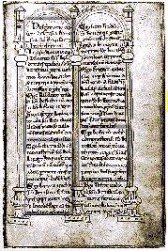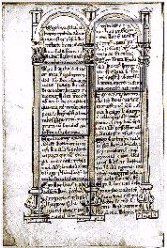
Last change:
30-3-2000;
reactions?
e-mail me
the history of Wieringen
the Middle ages
3. References to Wieringen
The first known references to Wieringen is in a goodslist of the monastery at Fulda, dating late 8 century, early 9th century. It's not the original, but a handed down list in a transcript made by Everhard of Fulda between 1150 and 1158, the socalled Codex Eberhardi. This monk tried to make a complete list of all property the monastery had acquired through the centuries and to do so he had studied and copied all old archivepieces. There are a number of clear references to goods on Wieringen:
1:
2:
|  |
 go Geltrud tradidi ad monasterium sancti Bonifacii omnem proprietatem meam in agris, silvis et de pratis ad XX carradas feni, in loco nuncupato Wictulfingafurt in pago Wironi… go Geltrud tradidi ad monasterium sancti Bonifacii omnem proprietatem meam in agris, silvis et de pratis ad XX carradas feni, in loco nuncupato Wictulfingafurt in pago Wironi… | |
I, Geltrud, have transferred to the monastery of St. Bonifacius all my property in fields, forests and from the meadows XX cart-loads of hay, on the place that is called Wictulfingafurt, in the area Wieringen. Wictulfingafurt is an unknown place. -Furt refers to a ford, a shallow place in a river where it is safe to cross. Think of places like Amerfoort, Frankfurt, Oxford, all carrying this postfix. In this case we have to think of a safe crossing near the family of Wictulf, somewhere in the moors between Wieringen and Texel or between Wieringen and Medemblik. |
4:
 go in Dei nomine Isanbalt et uxor mea Sigibirn de Fresia tradimus ad sanctum Bonifacium in villa que dicitur Brochenlar, in pago Wirah, quicquid proprietatis habuimus, hoc est de terra arabili quantum XI modus conseri potest… go in Dei nomine Isanbalt et uxor mea Sigibirn de Fresia tradimus ad sanctum Bonifacium in villa que dicitur Brochenlar, in pago Wirah, quicquid proprietatis habuimus, hoc est de terra arabili quantum XI modus conseri potest…
| |
In God's name I, Isanbalt and my wife Sigibirn from Friesland, transfer to St. Bonifacius in the manor Brochenlar, in the area Wieringen, all we had in property, that is of all the ploughland as much as can be sowed with XI mud (measure). Brochenlar is another untraceable place. It is most likely that Brochenlar is a writing error, and what is meant is Brocherlar: "broekelaar" This could refer to a piece of land west of Stroe called Broek(erpolder) wordt genoemd. The old local pronunciation was Brook. A manor ("villa") was the social building block in Carolingian times: an estate consisting of a hall and all subsequent housing and land. |
5:
 go Hunbertus tradidi ad sanctum Bonifacium quicquid mihi in regione Frésionum in pago Wirah mei reliquere parentes in hereditatem, cunctamque meam possessionem, hoc est in terris, agris, pratis, pascuis, silvis, aquis, domibus ac familiis… go Hunbertus tradidi ad sanctum Bonifacium quicquid mihi in regione Frésionum in pago Wirah mei reliquere parentes in hereditatem, cunctamque meam possessionem, hoc est in terris, agris, pratis, pascuis, silvis, aquis, domibus ac familiis… | |
I Hunbertus, have transferred to St. Bonifacius all that has been left to me from my parents in the county of the Frisians in the area Wieringen, and my complete possessions, being: fields, meadows, grassland, forests, waters, dwellings and all inhabitants. In Carolingian times family ("familia") meant the entire population of an estate. |
All these gifts are dated somewhere in the first 20 years of the 9th century. Since there are at least 5 manors, most of the time with serfs, this points to the importance of the region Wieringen. This impression is confirmed by the next source, the possessionslist of the St. Martinschurch in Utrecht, dated 948. The list was made for emperor Otto I and is written in past tense. It's most likely purpose is to give a list of property the church lost during the Viking raids (most of the 9th century).
The first reference speaks of a church domain at the Elft:
 e Wiron in Aluitlo mansum dominicatum cum terra salaricia sancti Martini, cum servis in eadem villa manentibus, quorum hec sunt nomina: Folkric, Offo, Radberth, Saxger, Thiemar, Redger, Redulf, Sinath, Reinger, Saxbrath, Aldo, Ricbald, Diacer, Wibald, Tiebo, Huno, Wlfbald, Adolf, Geldulf, Hildulf, Oatbald, Gerhelm, Betto, Saxger, Everbald, Ostlef, Osburg, Tatto, Edo. Quicquid isti habuerent nunc computatum in XII mansos, quorum Poppo I habet. e Wiron in Aluitlo mansum dominicatum cum terra salaricia sancti Martini, cum servis in eadem villa manentibus, quorum hec sunt nomina: Folkric, Offo, Radberth, Saxger, Thiemar, Redger, Redulf, Sinath, Reinger, Saxbrath, Aldo, Ricbald, Diacer, Wibald, Tiebo, Huno, Wlfbald, Adolf, Geldulf, Hildulf, Oatbald, Gerhelm, Betto, Saxger, Everbald, Ostlef, Osburg, Tatto, Edo. Quicquid isti habuerent nunc computatum in XII mansos, quorum Poppo I habet. |  | |
At Wieringen in Elft a dominial mansion with the saalland belonged to Saint Martin, with the serfs that live in that village, of whom the names are: Folkric etc. What they possessed has now been calculated at 12 farms. Saalland (salaricia) is the land that belongs to a mansion. It consists of ploughland, meadows and waste grounds (forest, heather, moor). A 9th century reference complete with names to serfs (only slightly better than slaves) is remarkable. If names are preserved from this period, they are almost always those of dignitaries. |
The next reference is to Stroe:
 | n Strude sexaginta et XII mansi qui fuerunt dei sanctorum Martini, Bonifacii, Willibrordi, Liudgeri, Landberti et domini regis. Inbante, Abbo, Alchrafan, Thrudlaf, Liudrad, Garhard, Siburg, Refnulf, Bulo, Folcolf, Garburg, Saxburg et frater ejus qui Thangburgam habuit, isti sunt sanctis Martini cum terra, quam habuerunt... | |
In Stroe 72 (sixty and twelve) mansions that have been of the Godly saints Martinus, Bonifacius, Willibrordus, Liudgerus, Landbertus and of the Lord King. Abbo etc etc. (translation last sentence unclear) It is most likely that these are the small farms of the free farmers, serfs and others who worked part of their time (3 days a week) on the lord's land. The mentioned saints were represented on earth by the churches and monasteries of Utrecht, Fulda, Echternach, Werden en Liège, in other words, the property was owned by these churches and monasteries. | ||
Finally a short sentence "Et in Uaroth similiter" = and in Varoth (Vatrop?) likewise.
Besides possessions the Utrecht list also mentions the right on the tenth of the wrecked goods found at Vatrop. Further it tells us that there must have been at least two churches in the region Wieringen, as early as the ninth century: "On Wieringen 2 parts of the entire land belong to [the church of] St. Martin, together with the churches of each of both; and in Vatrop likewise. Also St. Martin possesses the tenth of the ships that are driven there by heavy storms, because there is no toll." When this means that there are at Vatrop another 2 churches belonging to St. Martin, we should wonder if the Varoth in the text could not be another area.